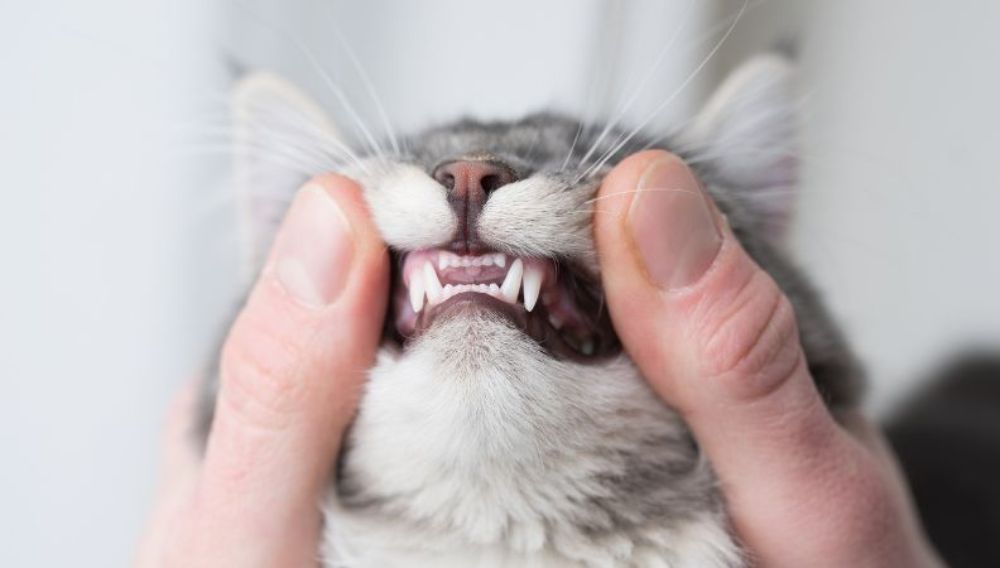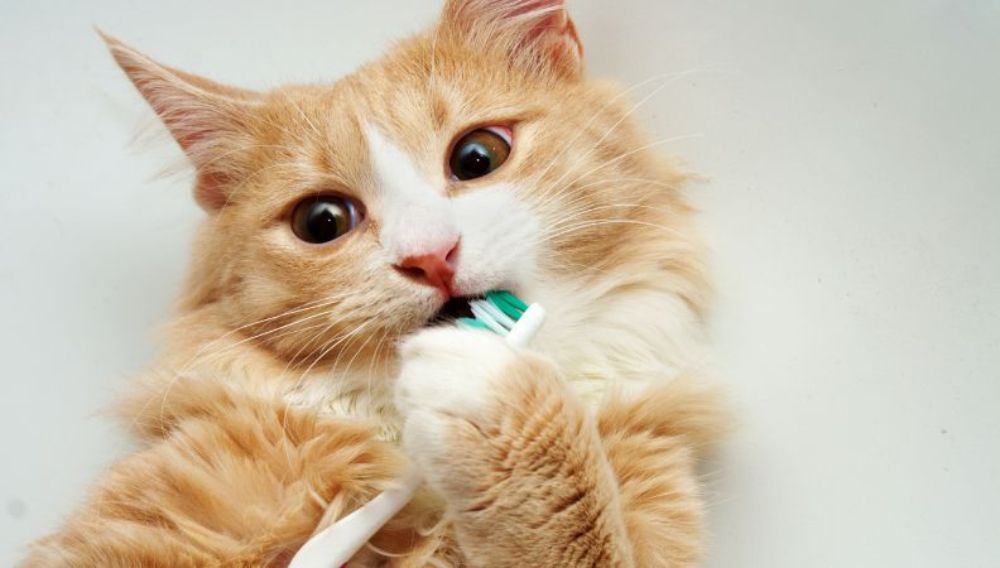
Keeping up on your cat’s oral health is a must for every cat owner. While at a glance your cat’s teeth are looking good, dental disease in cats is very common. Surveys have shown after the age of three, seven out of ten pets will suffer from some kind of dental problem, and you don’t want to worry about their unhealthy cat teeth.
Damage to a cat’s teeth, gum line and jaw bones may be irreversible so early intervention is needed. Home dental care is where it starts with prevention the name of the game!
Common Cat Teeth Problems
Cat dental disease shows signs with a build-up of plaque, a mixture of bacteria and debris that forms around the surface of the teeth. This yellow-white deposit hardens over time to form yellow-brown tartar (or calculus). The bacteria attack the gum, causing inflammation of the gums (gingivitis). If it’s severe your cat will have bad breath and may have difficulty eating because it’s painful.
Cats can also develop dental problems such as periodontal disease (inflammation of the structures supporting the teeth) and tooth resorption (when the hard tissue in the tooth is destroyed).
Gingivitis in Cats and How to Treat it
Gingivitis is inflammation of the gingiva (or gums), this causes pain and your cat may find eating difficult. Infection can set in, tracking all the way down to the root of the tooth. Pus may build up and form an abscess. The tooth can also become loose and fall out, bacteria can enter the bloodstream and cause even more problems.
The good news is that gingivitis can be treated. Your cat will need their teeth examined, the vet will take dental X-rays of your cat’s teeth under an anaesthetic and check for any deep tooth root abscesses. Any loose teeth will be removed, and your vet will use an ultrasonic scaling machine to remove the tartar and clean the remaining teeth.
Antibiotics may be given if there’s an ongoing infection. Your cat’s teeth will then be polished to leave a smooth surface which helps to slow down plaque build-up in the future. Your cat may need regular dental appointments for a scale and polish every 6 to 12 months.
Periodontal Disease and Treatment for Cats
The periodontium is the area that surrounds and supports the tooth - the periodontal ligament holds the tooth in its socket in the gum (gingiva). With periodontal disease, the ligament is destroyed, and symptoms of inflammation, bleeding and receding gums is usually seen before the tooth falls out.
Periodontal disease starts with plaque and tartar formation. This irritates the gum, makes the area more alkaline and allows bacteria to grow.
There are 4 Stages of periodontal disease:
- Stage 1 (gingivitis): inflammation of gums
- Stage 2 (early periodontitis): gum may bleed when probed
- Stage 3 (established periodontitis): gum recedes giving tooth less support
- Stage 4 (advanced periodontitis): tooth becomes loose
Your vet will determine which stage the periodontal disease is at by examining your cat’s gums and taking radiographs. Treatment depends on the stage. Stage 1 can be treated with professional teeth cleaning and dental care at home. Stages 2 and 3 can be treated with home care and an antibiotic gel while Stage 4 may require removal of the tooth or even gum surgery.
Treatment for periodontal disease can be expensive, especially if it has been left to get very bad. The best way to avoid periodontal disease is tooth brushing. Most cats will accept this if started gently when they’re young.
Cat Tooth Resorption
Another common dental problem in cats is tooth resorption (also known as Feline Odontoclastic Tooth Resorption or FORL). Over a third of cats may be affected. In this condition, the dental surface is destroyed by odontoclastic cells, and the root dental tissues are gradually replaced by bone.
Tooth resorption is classified into Stages 1-5 (or TR1-TR5):
- Stage 1 (TR1): mild dental hard tissue loss
- Stage 2 (TR2): moderate dental hard tissue loss
- Stage 3 (TR3): deep dental hard tissue loss, most of the tooth retains its integrity
- Stage 4 (TR4): extensive dental hard tissue loss, most of the tooth has lost its integrity:
- TR4a - crown and root equally affected
- TR4b - crown more severely affected than the root
- TR4c - root more severely affected than the crown
- Stage 5 (TR5): remnants of hard dental tissue are visible only on X-rays and gingival covering is complete (i.e. chronic lesion, complete resorption and replacement by bone).
Cats with FORL find it painful to eat and may change their eating habits. The exact cause of tooth resorption remains unknown and surgery to remove the affected tooth is the only treatment, but the affected teeth are very fragile, and fractures are common. X-rays are essential to make sure all fragments of the tooth and roots have been removed during the extraction. Any fragments left behind can cause infection.
All of this can make the cost of resorption treatment mount up. Your cat will also need to have dental and oral appointments every 3 months to monitor healing and to check for any other affected teeth.
Preventative Dental Care

In the wild, cats needed to have strong, sharp teeth to eat the prey that they caught. This kept their teeth in good condition. Pet cats are fed soft or wet food, which isn’t a great diet for maintaining good dental health.
Adding more dry and fibrous foods like kibble into their diet will help reduce plaque. But never give them cooked bones as these can splinter and cause problems. Special diets for dental care and dental treats and chews are available - ask your vet if your cat might benefit from these.
The most important thing is brushing your cat’s teeth! Get them used to having their teeth cleaned from an early age. Brushing your cat’s teeth may involve patience and perseverance before your cat accepts the routine but regular brushing (ideally every day or at least 3 times a week) will reduce the risk of advanced dental disease developing.
Before you root around your cat's mouth with a toothbrush, Everypaw Vet Dr Anna Foreman and our pals at Vetstream are here with all the cat teeth cleaning tips you need.
Everypaw Cat Insurance
Everypaw's Cat Insurance comes with 24/7 unlimited access to vets and vet nurses that can help with your pet's health, care, nutrition and behaviour. So you can rest assured your kitty will be well looked after.
If you take out an Everypaw Cat Insurance policy, dental cover is included in your vet fee cover. You just need to make sure you look after your cat's teeth, take them for regular check-ups and make sure you follow your vet's advice.
Content provided from Vetstream's Vetlexicon Felis - www.vetlexicon.com/felis
Vetlexicon is the world’s largest peer-reviewed online clinical reference source. All our content is written and peer-reviewed by over 1,000 of the world’s leading veterinarians, ensuring relevance, accuracy and quality.
- Vetstream Ltd (online) Dental disease in your cat. In: Vetlexicon Felis. Vetstream Ltd, UK. Website: https://www.vetlexicon.com/treat/felis/client-information/dental-disease-in-your-cat
- Vetstream Ltd (online) Periodontal disease and how to prevent it. In: Vetlexicon Felis. Vetstream Ltd, UK. Website: https://www.vetlexicon.com/treat/felis/client-information/periodontal-disease-and-how-to-prevent-it
- David Crossley, Alex Smithson (online) Gingivitis and stomatitis. In: Vetlexicon Felis. Vetstream Ltd, UK. Website: https://www.vetlexicon.com/treat/felis/diseases/gingivitis-and-stomatitis
- David Crossley, Alex Smithson (online) Odontoclastic(online) tooth resorption (resorptive lesions). In: Vetlexicon Felis. Vetstream Ltd, UK. Website: https://www.vetlexicon.com/treat/felis/diseases/odontoclastic-tooth-resorption-(resorptive-lesions)